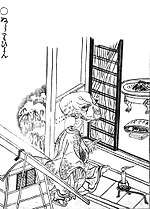Nurarihyon

Nurarihyon (ぬらりひょん, alternatively 滑瓢), or Nūrihyon (ぬうりひょん), is a Japanese Yōkai said to originate from Wakayama Prefecture. It is speculated that the original name used was Nūrihyon, with Nurarihyon being a misreading that got perpetuated.[1][2]
Etymology
The name Nurarihyon is a portmanteau of the words "Nurari" (Japanese: ぬらり or 滑) meaning "to slip away" and "hyon" (Japanese: ひょん or 瓢), an onomatopoeia used to describe something floating upwards. In the name, the sound "hyon" is represented by the character for "gourd".[3] The Nurarihyon is unrelated to another, similarly named ocean Yōkai from Okayama Prefecture.[4]
Appearance and behaviour

The Nurarihyon is usually depicted as an old man with a gourd-shaped head and wearing a kesa.[3]
The Nurarihyon is often depicted sneaking into people's houses while they are away, drinking their tea, and acting as if it is their own house.[4][5] However, this depiction is not one based in folklore, but one based on hearsay and repeated in popular Yōkai media.[4][6]
Notes
- ↑ Murakami 2000, p. 255.
- ↑ Kyōgoku & Tada 2000, p. 149-150.
- 1 2 Meyer 2013, p. "Nurarihyon".
- 1 2 3 Foster & Kijin 2014, p. 218.
- ↑ Mizuki 1994, p. 344-345.
- ↑ Kyōgoku & Tada 2000, p. 149.
References
- Davisson, Zack (March 2015). "Back Matter: Nurarihyon". Wayward Volume One: String Theory. Image Comics. ISBN 978-1-63215-173-5.
- Foster, Michael Dylan; Kijin, Shinonome (2014). The Book of Yōkai: Mysterious Creatures of Japanese Folklore. University of California Press. ISBN 9780520271029.
- Kyōgoku, Natsuhiko; Tada, Katsumi (2000). Yōkai Zukan. Kokusho Kankōkai. ISBN 978-4336041876.
- Meyer, Matthew (2013). "Nurarihyon". yokai.com. Retrieved 22 May 2016.
- Mizuki, Shigeru (1994). Zusetsu Nihon Yōkai Taizen. Kōdansha. ISBN 9784062776028.
- Murakami, Kenji (2000). Yōkai Jiten. Mainichi Shinbunsha. ISBN 978-4620314280.
See also
External links
| Wikimedia Commons has media related to Yuki-onna. |
- Nurarihyon – The Slippery Gourd at hyakumonogatari.com (English).
- Nurarihyon from Yōkai on Mizuki Shigeru Road: Sakaiminato Sightseeing Guide (in Japanese)
